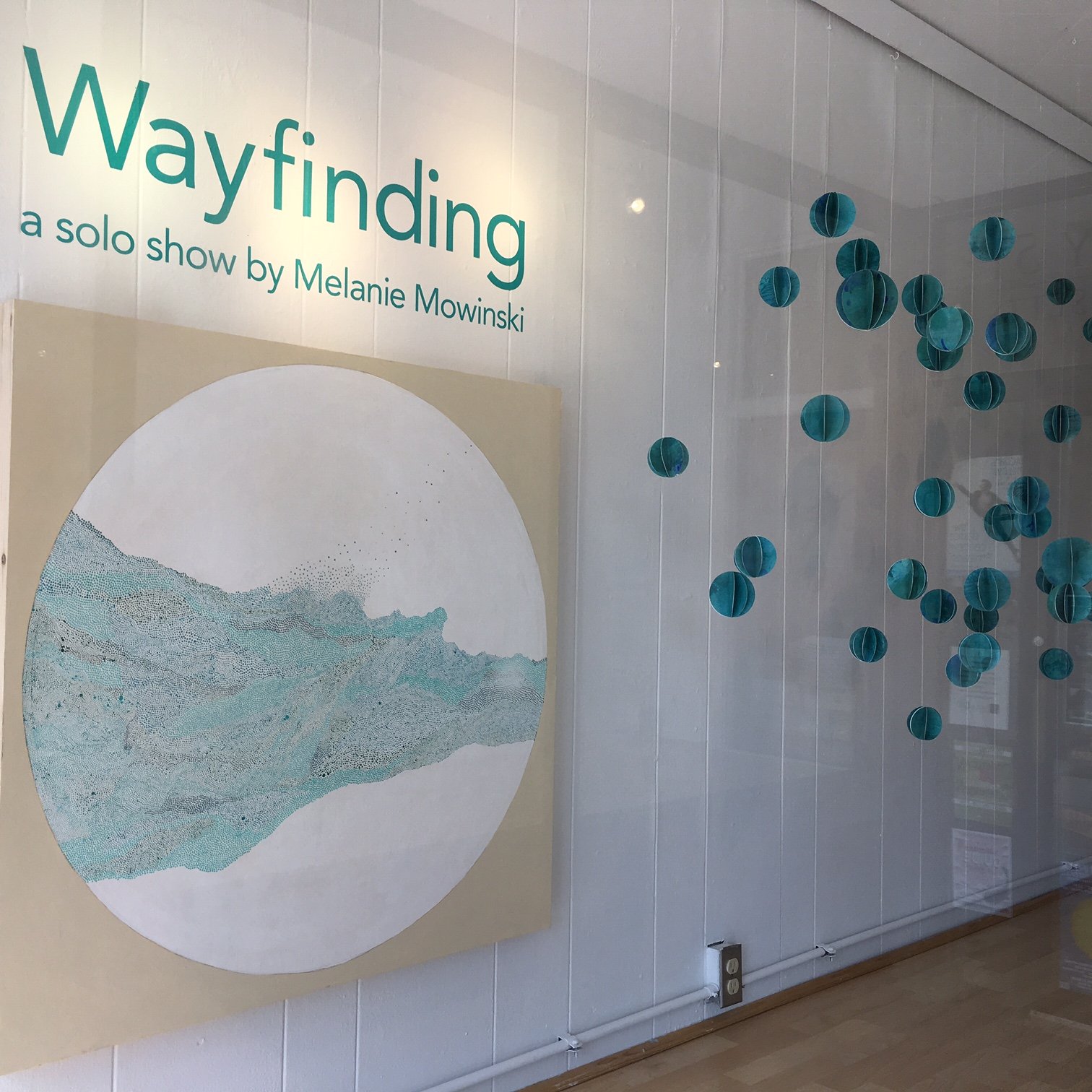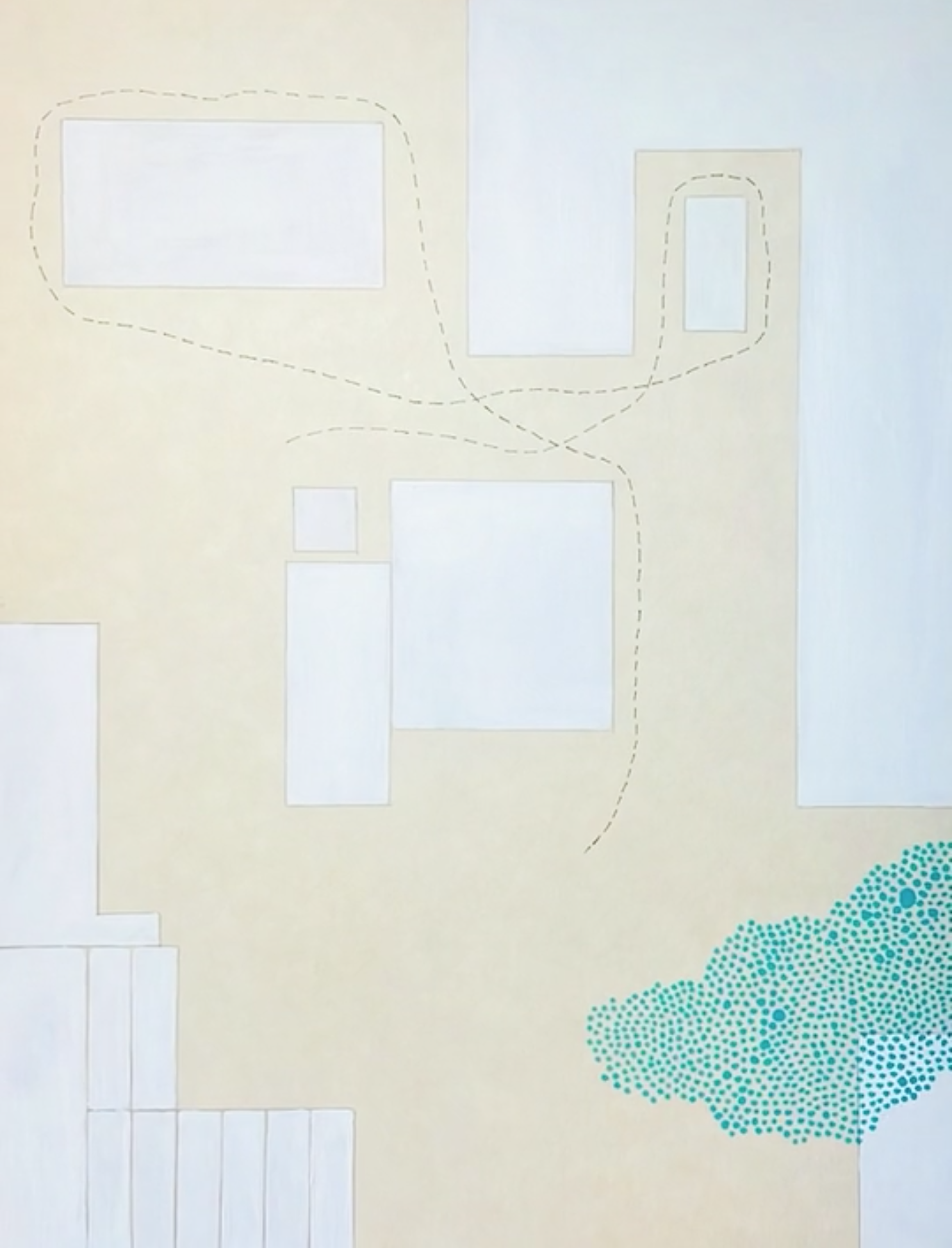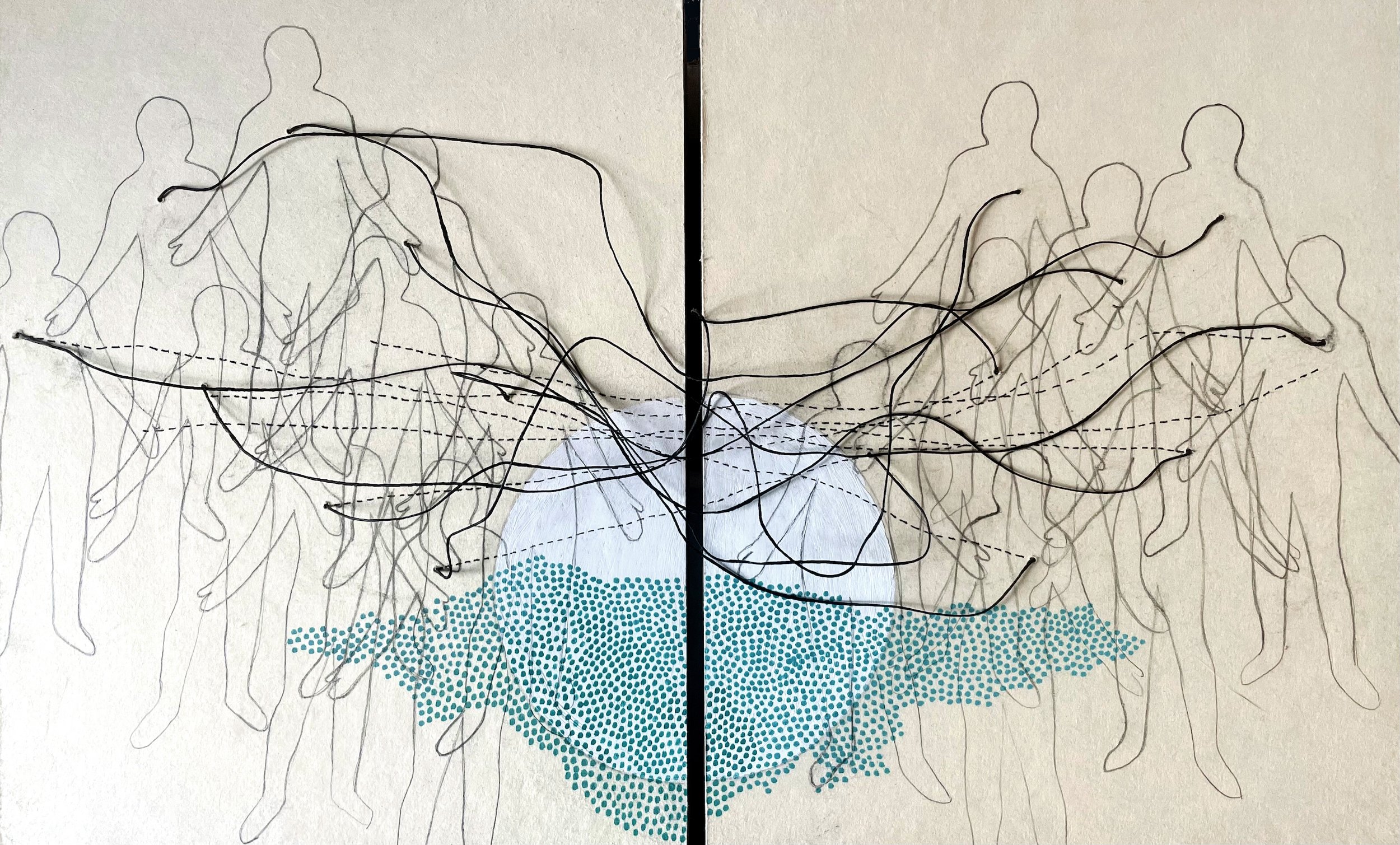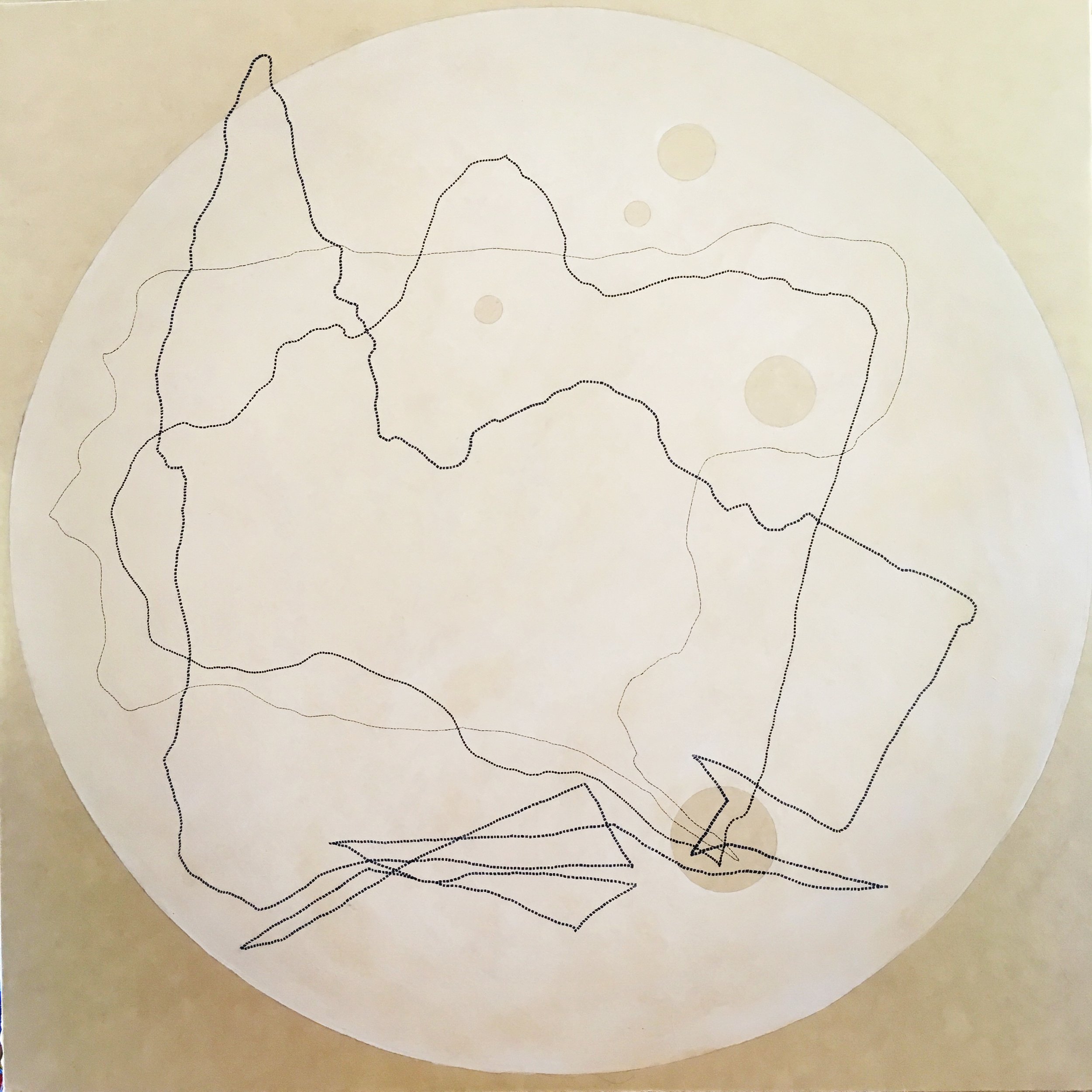
Above: detail from Melanie Mowinski, A lot can happen in a year, 2016. Ink and gesso on paper mounted on board with painted paper installation of 366 paper dots.
Melanie Mowinski:
Long-Distance Drawing; evolutions of Wayfinding
From 2016-2019, artist Melanie Mowinski made drawings and related works as part of the Wayfinding series, which mapped her walks and runs across America and Europe using a signature practice of repetitive, experimental mark-making — a strategy that exploits the many meanings contained within even the simplest of gestures. Wayfinding, the artist wrote at the time, was
“about trusting the way and understanding the many paths to get to the same destination literally and figuratively. Some are direct others are tranquil. Some avoid obstacles. And others are just variety and keep your mind alert for new things. I define this as cultivating a wilderness state of mind. Accepting the wilderness is about being present to the unpredictability of life, the knowledge that while we think we are on a safe path walking in the New England forest, a black bear could appear out of nowhere. Or your trust in your reality can be jolted when a person decked out in 17th century finery emerges from around a corner during Carnevale in Venice.”
What Mowinski didn’t know, however, was that this body of work would inadvertently document her final days as a long-distance runner due to the physical decline of her hips. With running and walking no longer able to serve as crucial forms of fitness and focus in the same ways, Mowinski committed to think about other ways of using “time and repetition in meditation, to create spaces of ease within one's life.”
Out of these concerns, Mowinski developed the concept of long-distance drawing, inspired by accounts of imaginary walks that she was introduced to in Merlin Coverley’s The Art of Wandering: The Writer as Walker (Old Castle Books, 2012). Mowinski’s work extends traditions of creativity— including Xavier de Maistre’s A Journey Around my Room (1795) and a A Nocturnal Expedition Around My Room (1825); John Finley’s Traveling Afoot (1930s); and Albert Speer, Spandau: The Secret Diaries (1975), in which Speer walked imaginatively to various places while incarcerated — that speak to the extraordinary capacity of the imagination to negotiate and transform various forms of limitation.
In the video documenting the creation of a long-distance drawing below, titled Walking a Mile in my Kitchen, there are roughly two-thousand small marks, each of which represent a step in a mile-long walk around the first floor of the artist’s home. While it takes the artist about 20-25 minutes to perform this walk, it takes between three and four hours to draw and compile this work into a film. Mowinski heightens this intensely durational experience for the viewer even further, by employing various possibilities of stop-motion animation.
When asked about resonances between these drawings and the module I Can’t — specifically, about differences and continuities between these two series, as well as about how this work has inflected her thoughts about capacity and pain — Mowinski shared the following with the CARE SYLLABUS team, edited and condensed here:
“In the Wayfinding series, the abstract forms of the maps reflects the fact that I was exploring places in nature, and their organic sense is intentional. Similarly, so is the hard edged quality of the house in the Long-Distance Drawing series – it could be a city, but it is also supposed to feel containing, and distinct from the freedom of the natural world. In the contrast between hard edge and soft edge, there are parallels to the pandemic, and the way that so many people were contained to their homes, contained from the world. Accepting the hard edges, to see how they might soften, also connects directly to the “I can’t” and the process of considering the physical limitations of my body.
Across the scenarios – of being in nature or the city; and of being in my home – this work shares certain qualities: of dealing with the unexpected, because there is a lot that we can learn when things are unknown. When we're lost or in a new scenario, there is an element of paying attention differently, and this is equally true about the process of learning to notice something about your own body that you weren’t already attuned with.
Anyone who deals with chronic pain, as I have, knows that there is a certain amount of energy that goes into caring for it, and a certain kind of exhaustion that requires tremendous mental capacity to navigate. You have to coach yourself through small moments, to get through other stresses and workloads and highs and lows of the day with this pain. One part of making this work, for me, is about validation and recognition – it’s about owning these experiences, about knowing that what you’re experiencing is real, about sharing this with others, and about holding space for all these conversations in which we respect each person’s experience in their own body.”
Screening:
Walking a Mile in my Kitchen, from the Long-Distance Drawing series (2022)
Walking a Mile in my Kitchen, part of the Long-Distance Drawing series, maps a mile-long walk around Mowinski’s home that she tracked with the help of a step counter. Using stop-motion animation, Mowinski alters playback speeds — here, they are longer and shorter than the record-breaking paces for mile-long runs — to simulate different experiences of endurance for the viewer.
Gallery:
Selections from Wayfinding (2016-19)
Below is a selection of works from Wayfinding, the series out of which Mowinski’s Long-Distance Drawing series has grown. These works use, among other symbols, dots , dotted lines, circles, penciled lines, and birds, to represent different aspects of Mowisnki’s journeys across a number of American and European cities.
“From January-July 2016,” Mowinski writes, “I walked the city streets of Venice, New York City, Memphis, Cleveland, Oak Park, Chicago, and Miami; and smaller towns like Nebraska City, North Adams, Clarksdale, and Pittsfield. I hiked in Italian and German hillsides, the Berkshires, the Nebraskan and Iowian planes, the parks of Ohio, the soy and corn fields of the South and the levees of the Mississippi. Many walks were tracked with electronic devices. Others through drawings and writings in order to uncover the changing focus of my attention while finding my way.”
About the artist
Melanie Mowinski lives and works in the Berkshires of Massachusetts where she is a professor of art at the Massachusetts College of Liberal Arts (MCLA). Mowinski holds an MFA from The University of the Arts in Philadelphia and an MAR from Yale University.
Mowinski balances hyper control & very specific rules with experimental investigations in her letterpress and book art work, often gravitating towards one-of-a-kind books housed in unusual and traditional enclosures. Her books under the imprint PRESS • 29 PRESS are in private and public collections including Williams College, Yale University, Colorado College, Denison University Library, Lafayette College, The Newark Museum, Baylor University, The University of Iowa, Bainbridge Island Museum of Art, Ohio University, The Free Library of Philadelphia, The Ruth Hughes Collection at Oberlin College, Tate Modern Museum of Art in London, Simon Fraser University, Cornell University, UCLA, USC, Emory University, Lafayette College, Library of Congress, Smithsonian American Art & Portrait Gallery Library and University of Nebraska-Lincoln.
Learn more about Mowinski’s work at the artist’s website.







